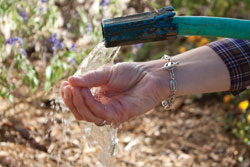
Table of Contents
Features
Agriculture: We Can Sustain It
Socializing Agriculture
Painter of Quiet Places
An Apple a Day
Sustaining the Four Sixes
Hitting Pay Dirt
The New Face of Agriculture
The Winds of Change
Avatars Animate Agriculture
Professors in Training
Going Green
Saving Lives One Plan at a Time
Protecting Our Food
Quality Cells, Consumer Buys
Tech's New Mate
Micro ZAP
Food Saftey in Mexico
Expanding Opportunities
No Bits About It
The Family Farm Fire Man
Around the World with CASNR
Live From Texas Tech
Looking Forward
Getting Schooled
A Cotton Senstaion
Living and Learning
More Than a Trophy
Online Exclusives
Alumni Lance Barnett: Unpeeled
Agricultural Education and CommunicationDepartment Shines in 2010
CSI: Classroom Soil Investigation
Facing Nature
GINuine
Healing Hooves
Parking and Partying in Style
Raider Red Meats
Standing TALL
Tech Takes Flight
West Texas Cotton Goes Global
Hitting Pay Dirt
By Kelsey Fletcher

In a region famous for tumbleweeds, red dirt and long periods of drought, area farmers hope for a light rain shower to quench the thirst of area crops. Until that precipitation arrives, many farmers will turn to irrigation to provide crops with the water they need. So each time a change in water policy is under consideration for one of the area’s water districts, West Texas farmers usually have something to say.
One simple change in these regulations could have a severe impact on an area farmer’s livelihood.
However, even those who live in more urban areas of the South Plains can be drastically affected by the same changes in water policy. Decreased profit for a cotton farmer could create higher denim prices for clothing retailers with these same increases passed along to area consumers. The problem is sometimes these consumers do not see the direct connection between changes in area water laws and an increase in the price of jeans at a store. Researchers at Texas Tech University and Texas A&M University have been working with the Texas AgriLife Extension service to bridge the gap.
Led by Texas Tech researchers, the Farm Forward research study focused on the economic impact of groundwater use throughout the South Plains. The researchers reviewed data from past and current studies involving groundwater irrigation and collected additional data from state commodity groups. With that information, the team created a new model which will be used to project possible impacts of changes in water regulation on the overall economy.
Larry Combest Endowed Chair for Agricultural Competitiveness at Texas Tech Darren Hudson, served as one of the leaders of the research effort.
“This is a unique approach to this kind of analysis that isn’t done anywhere else in the country,” Hudson said. “We’re really on the forefront of being able to link policy debates to regional economic activity through the agricultural sector. It’s a great project from a lot of different standpoints – the collaboration between the universities, the uniqueness of it in terms of its ability to answer policy questions, and it allows us to be able to say something more than just the impacts on an ag producer or consumer.”
Previously, Hudson’s team conducted studies in various locations across the High Plains to see the effects a change in water regulation would have on a specific commodity. In these studies, agricultural economists previously used a model dubbed the “IMPLAN model” developed by the Minnesota IMPLAN Group, Inc. to analyze the data. Jeff Johnson is an assistant professor of agricultural and applied economics at Texas Tech and has worked with Hudson on several of these research efforts.
Johnson also serves as Associate Director of Texas Tech’s College of Agricultural Sciences and Natural Resources Water Center.
“The models that we used in previous research only looked at backward linkages,” Johnson explained. “We consider all of the things that go into producing that product such as fertilizer, water, seed and labor. So previously, we’ve explored the idea that if we change final yields, how will that change ripple back? We did not look at what happens as the product goes forward through processing. For instance, looking at cotton, the previous research doesn’t look at the impacts of a change in cotton yield on a gin, compress, or even denim mill. That is what this Farm Forward project is going to do.”
These effects are measured using distinct economic categories. Direct economic impacts are basically sales figures. Indirect economic impacts are ones traced back into process inputs, such as labor or purchased grain for processing. Induced economic impacts stem from changes in household income caused by direct and indirect effects; changes in employment, meaning jobs created or lost, are also considered in these measurements.
Bridget Guerrero works for the Texas AgriLife Extension service as a program specialist and is also a crucial researcher on the project.
“The commodities we had been considering before were still pretty raw when they were produced,” Guerrero stated. “We knew we were still missing some things because agricultural commodities are not in their final forms. They’re not a loaf of bread or a pair of jeans, so we are missing those forward linkages. That is what this study is for. We have to develop our own models that will be specific for water districts in this region. It can be used for not only water districts, but also commodity groups. Eventually, we will be able to look at more general areas like the Panhandle or the South Plains, and even the entire State of Texas.”
The project was launched in April 2010 through financial contributions from area commodity groups. Five area water districts and six area commodity group leaders serve on a steering committee for the project.
Economists will use this newly-developed model to produce results related to potential policy changes. Hudson explained the focus of this initial research was water regulation, but the information produced with this model could be used in any policy discussion. The model could potentially be crucial to discussions regarding the upcoming 2012 Farm Bill provisions. In other words, the outcome of the project is not a specific policy recommendation, but a procedure for analyzing different policy options and their effects on an area’s economy.
There are still difficult questions yet to be answered by either the original IMPLAN or new Farm Forward model. One issue is the Lubbock area grows around 80 percent of the world’s sorghum. If Lubbock-area water regulations are changed and have an effect on sorghum production, it will have a direct economic impact worldwide.
“The model doesn’t capture the impact of losing the hybrid sorghum seed sector here on the rest of the world,” Hudson pointed out. “It could be a tremendous impact, but we don’t have any way of valuing that. There are going to be some sticky questions we have yet to sort out.”
Hudson said the research team hopes the data their model is capable of producing will establish Texas Tech economists as a vital component of future policy discussions.
“We actually did some water policy analysis that we reported a couple of years ago looking at how policy would affect farm level and the region,” Johnson said. “I can’t say our research has had any impact on legislation. What I think it does is add a little more information for the decision-makers. There are too many other aspects that go into the political decisions to say that the economic piece is the driver, but what we hope to gain is that it becomes a part of the discussion.”